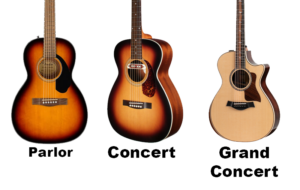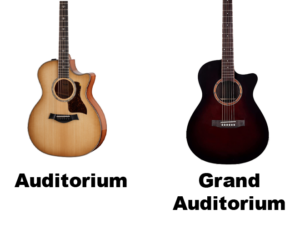Uncategorized
Unveiling the E♭ Guitar Chord: A Beginner’s Guide
Embarking on a musical journey with the guitar is like stepping into a world of melodies, rhythms, and harmonies waiting to be explored. As a beginner, discovering new chords is an essential step toward becoming a confident and skilled player. Among these chords, the E♭ guitar chord, also known as E flat, holds a special place. In this article, we’ll dive into the captivating realm of the E♭ guitar chord, explore its formation, provide practical fingering tips, and unveil its significance in crafting beautiful music. Prepare to unravel the secrets of the E♭ guitar chord and enhance your guitar-playing skills!
Introducing the E♭ Guitar Chord
The E♭ guitar chord, also known as E flat, is a unique combination of notes that adds depth and richness to your chord progressions. Comprising three notes – E♭, G, and B♭ – the E♭ chord introduces you to the world of major chords, offering a versatile sound that can be applied to various musical styles.
Mastering the E♭ Guitar Chord
Follow these simple steps to master the E♭ guitar chord:
1. Place Your Fingers: Begin by placing your index finger on the 1st fret of the G string (third from the top). Next, position your middle finger on the 2nd fret of the A string (second from the bottom), and your ring finger on the 3rd fret of the D string (fourth from the top).
2. Strum the Chord: Strum from the A string (second thickest) to the high E string (thinnest), making sure each string produces a clear, resonant sound.
Press your fingers down firmly on the strings and avoid touching adjacent strings to prevent any unintended buzzing or muting.
Benefits of the E♭ Guitar Chord
Learning the E♭ guitar chord offers several advantages for beginner guitarists:
1. Versatility: The E♭ chord is versatile and can be used in a variety of musical genres, from pop and rock to jazz and beyond. Its unique sound adds depth to your chord vocabulary.
2. Chord Progressions: Incorporating the E♭ chord into your chord progressions creates interesting and dynamic transitions, enhancing the overall musical flow.
3. Finger Strength and Coordination: Mastering the E♭ chord helps develop finger strength and coordination, two essential skills for becoming a proficient guitarist.
Practical Tips for Mastering the E♭ Guitar Chord
Here are some practical tips to help you perfect the E♭ guitar chord:
1. Begin Slowly: Start by forming the E♭ chord shape slowly and ensure each string rings out clearly. Pay attention to your finger placement and apply gentle pressure to the frets.
2. Isolate Finger Movements: Practice placing each finger on the frets individually before forming the full chord shape. This builds muscle memory and finger strength.
3. Chord Transitions: Work on transitioning between the E♭ chord and other chords you know. This improves your ability to switch chords smoothly during songs.
Famous Songs Featuring the E♭ Guitar Chord
The E♭ guitar chord’s distinctive sound is found in numerous well-known songs across genres. Here are a few examples:
1. “Imagine” by John Lennon: The E♭ chord contributes to the song’s timeless and reflective quality, creating a sense of introspection.
2. “Let It Be” by The Beatles: The E♭ chord is part of the iconic chord progression that adds to the song’s calming and comforting atmosphere.
3. “Don’t Stop Believin'” by Journey: The E♭ chord adds to the song’s uplifting and anthemic feel, making it a favorite in many sing-along moments.
Conclusion
Congratulations, you’ve delved into the captivating world of the E♭ guitar chord! By mastering this unique chord shape, you’ve gained a powerful tool that can elevate your guitar playing and add a new layer of depth to your musical repertoire. Whether you’re strumming along to your favorite tunes, composing your melodies, or experimenting with chord changes, the E♭ guitar chord enriches your musical palette.
As you continue your guitar-playing journey, remember that practice and dedication are key to mastering any new chord. Don’t be discouraged by initial challenges – with consistent effort and a passion for learning, you’ll find yourself transitioning smoothly between chords and creating captivating music that resonates with your unique style.
The E♭ guitar chord is just the beginning of your musical exploration. As you delve deeper into the world of guitar playing, you’ll encounter a variety of chords, techniques, and melodies that will enhance your musical experience. So, keep strumming, keep learning, and most importantly, keep enjoying the wonderful journey of creating music with your guitar. Happy playing!
Uncategorized
Acoustic Guitar Sizes: Finding Your Perfect Fit
Have you ever wondered how the size of an acoustic guitar affects its sound? From the intimate, focused tones of a parlor guitar to the deep, resonant sound of a jumbo, the size and shape of an acoustic guitar can have a profound impact on its sonic characteristics.”
In this article, we’ll explore acoustic guitar sizes, their variations, and how to choose the perfect size that suits your needs.
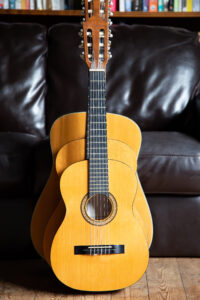 Understanding Acoustic Guitar Sizes: A Musical Puzzle
Understanding Acoustic Guitar Sizes: A Musical Puzzle
Acoustic guitar sizes refer to the dimensions and proportions of the guitar body, which significantly influence the instrument’s tonal characteristics, projection, and playability.
Just like pieces of a musical puzzle, different sizes create distinct voices that cater to various playing styles and preferences.
The Spectrum of Acoustic Guitar Sizes
Acoustic guitars come in several sizes, each with its unique qualities and attributes. Let’s explore some common acoustic guitar sizes and their defining features:
-
-
Parlor Guitar: The parlor guitar is petite and charming, making it an ideal companion for intimate settings.
The name comes from the rooms in which the guitar was typically played in the late 19th century.
Some famous musicians who have been known to use the parlor guitar are, Eric Clapton, Mark Orton, Ed Sheehan, and John Mayer
Its smaller size results in a focused and balanced sound, perfect for fingerpicking and folk music.
-
Concert Guitar: Slightly larger than the parlor guitar, the concert guitar offers enhanced projection and volume. It strikes a balance between portability and sound, making it versatile for various genres.
It is often used in classical music and flamenco music with its full sound.
-
Grand Concert Guitar: With a larger body than the concert guitar, the grand concert guitar boasts a fuller sound and improved tonal complexity.
A popular choice for those who have a smaller stature and require an instrument that’s built to a shorter scale. Great choice for traveling musicians who often play live performances.
It’s suitable for fingerstyle playing and intricate arrangements.
-
Auditorium Guitar: The auditorium guitar, also known as the orchestra model (OM), features a well-rounded sound with a pronounced midrange.
More shallower than the dreadnought and narrower in width than a concert guitar. An Auditorium guitar brings the body closer to the player, making it feel more intimate and comfortable for stage use.
Some famous musicians who play it include Ed Sheeran, John Mayer, and Eric Clapton.
-
Grand Auditorium Guitar: Expanding on the auditorium guitar’s design, the grand auditorium guitar offers a versatile sound profile with enhanced bass response and overall volume.
It is a versatile mid-sized guitar that is a good choice for those who want a single guitar to travel with. The tone is great for strumming and picking. It performs well on stage and in the studio.
It suits a wide range of musical genres.
-
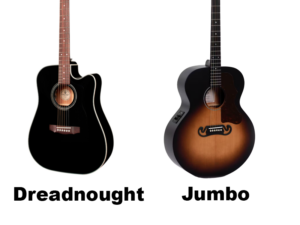 Dreadnought Guitar: The Dreadnought is a true icon, known for its bold and powerful sound. Its large body produces a strong bass response, making it ideal for strumming and vocal accompaniment.
Dreadnought Guitar: The Dreadnought is a true icon, known for its bold and powerful sound. Its large body produces a strong bass response, making it ideal for strumming and vocal accompaniment.This guitar is known for its powerful voice and lower-mid-rich tones that make it a favored choice for country artists. Although it is a popular choice for musicians of all genres.
Some famous musicians who play the dreadnought guitar include Hank Williams Jr, Elvis Presley, Keith Richards, Thom Yorke, and Kurt Cobain.
The original dreadnought guitars were made for the Oliver Ditson Company and featured mahogany backs and sides and spruce tops.
-
Jumbo Guitar: The jumbo guitar lives up to its name with a massive body that delivers robust volume and a deep bass presence.
This is the largest of the guitar family with a deeper body than the popular dreadnought. The body is wider and deeper than traditional acoustic guitars, which gives them a unique appearance.
Jumbo’s are well suited to rhythm guitarists in country and folk rock, and produce a deep rich sound favored by heavy strummers. Some famous musicians who play this guitar are Elvis Presley, George Harrison of the Beatles, Neil Young, Sheryl Crow, and Pete Townshend of The Who.
Choosing the Right Acoustic Guitar Size for You
Selecting the right acoustic guitar size involves considering factors such as playing style, comfort, and tonal preferences. Here are some steps to guide you on your quest:
-
Identify Your Playing Style: Determine whether you lean towards fingerpicking, strumming, or a mix of both. Different sizes excel in different playing styles, so choose one that complements your technique.
-
Consider Body Comfort: Hold and play guitars of various sizes to assess comfort. A guitar that fits well against your body ensures a pleasant playing experience, especially during extended sessions.
-
Evaluate Sound Preferences: Listen to the sound produced by different acoustic guitar sizes. Pay attention to tonal qualities, such as warmth, brightness, and projection, to find the one that resonates with your musical taste.
The Influence of Acoustic Guitar Sizes on Music
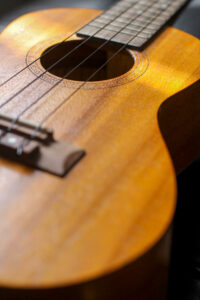 Acoustic guitar sizes and shapes can have a significant impact on the sound of the instrument.
Acoustic guitar sizes and shapes can have a significant impact on the sound of the instrument.The size of the guitar body type also relates to the volume of air within the instrument. Changes to the air capacity of the body will emphasize specific frequencies. A smaller body will have a more focused sound centered on higher frequencies, while a larger body will produce deeper low-end frequencies.
Body dimensions can provide some indication of the tone you might expect, but other factors exert a profound influence, too. Much depends on the tonewoods used to construct the body and the shape, size, and layout of the braces.
Finding Harmony in Acoustic Guitar Sizes
By delving into the nuances of size, sound, and playability, you’ve gained insights that will guide you toward the perfect fit for your musical aspirations.
As you continue your exploration, remember that each acoustic guitar size has its own unique voice and character. Embrace the joy of trying different sizes, celebrate the nuances of their sounds, and let your heart lead you to the one that resonates with your musical soul.
-
Uncategorized
How to Hold a Guitar: Your Guide to Proper Guitar Posture
Greetings, aspiring guitarists and music enthusiasts! Are you ready to embark on a journey of proper guitar posture and discover the essential techniques for holding your guitar with comfort and ease? In this guide, we will explore the fundamental principles of how to hold a guitar, ensuring that you set the foundation for a lifetime of enjoyable playing. Whether you’re a beginner taking your first steps in the world of music or someone seeking to refine your technique, this article is your roadmap to mastering the art of holding a guitar. So, grab your instrument, find a comfortable spot, and let’s dive into the harmonious realm of proper guitar posture!
Why Proper Guitar Posture Matters
Before we delve into the specifics of how to hold a guitar, let’s understand why proper posture is crucial. Maintaining the correct posture not only enhances your playing technique but also prevents discomfort, strain, and potential injuries. Whether you’re strumming chords or shredding solos, adopting the right posture ensures optimal control over the instrument and facilitates fluid movement along the fretboard.
Sitting Position: The Foundation of Proper Posture
When sitting down to play the guitar, follow these steps for optimal posture:
1. Find a Comfortable Chair: Choose a chair with a straight back and no armrests. Ensure that your feet are flat on the ground, creating a stable base.
2. Place the Guitar: Sit on the edge of the chair, allowing the guitar body to rest on your right thigh (if you’re right-handed) or left thigh (if you’re left-handed).
3. Angle the Neck: Tilt the neck of the guitar slightly upward, maintaining a natural angle between your wrist and the neck.
4. Curved Back and Shoulders: Keep your back comfortably straight, avoiding slouching. Relax your shoulders and let your arms hang naturally.
5. Elbow Placement: Position your right forearm (or left forearm) on the upper bout of the guitar, ensuring your forearm and elbow are not raised too high.
Standing Position: Rocking the Guitar Onstage
If you prefer to stand while playing, follow these guidelines:
1. Adjust the Strap: Use a guitar strap to adjust the guitar’s height. The guitar should rest at a comfortable level on your body.
2. Balanced Weight: Distribute the weight of the guitar evenly across your body by adjusting the strap length.
3. Natural Arm Position: Keep your picking hand relaxed, with your forearm parallel to the floor. Maintain a slight bend in your elbow for ease of movement.
4. Stance and Mobility: Stand with your feet shoulder-width apart to maintain stability. Bend your knees slightly for flexibility and better control.
Guitar Position: Fretting Hand Technique
The position of your fretting hand greatly influences your playing technique:
1. Thumb Placement: Place your thumb behind the guitar neck, supporting it without gripping too tightly. This allows your fingers to press down on the strings more effectively.
2. Finger Arch: Maintain a curved finger arch when pressing down on the strings. Avoid letting your fingers collapse, as this can lead to muted or buzzed notes.
3. Finger Placement: Position your fingers perpendicular to the frets, ensuring that you press down on the fingertips and not the pads.
Strumming and Picking Hand Technique
Your strumming or picking hand technique complements your fretting hand posture:
1. Picking Hand Position: Hold the pick between your thumb and index finger. Keep your wrist relaxed and allow your hand to move freely across the strings.
2. Strumming Arm Movement: For strumming, use a fluid motion from your elbow, creating a pendulum-like movement. Experiment with various strumming patterns.
3. Palm Muting: When palm muting, lightly rest the side of your picking hand near the bridge to achieve a muffled sound.
Additional Tips for Proper Guitar Posture
Here are some extra tips to ensure you’re holding the guitar correctly:
1. Practice Patience: It may take time for your body to adjust to the proper posture. Be patient and allow yourself to build muscle memory gradually.
2. Regular Breaks: Take breaks during practice sessions to stretch and relax your muscles. This helps prevent strain and fatigue.
3. Mirror Check: Practice in front of a mirror to visually assess your posture and technique. Adjust as needed for improved alignment.
Conclusion: Mastering the Art of Proper Guitar Posture
Congratulations, you’ve now embarked on a journey toward mastering the art of holding a guitar with proper posture! By following these guidelines and incorporating them into your practice routine, you’re setting the stage for a fulfilling and enjoyable musical journey. Remember, the foundation of proper posture is built upon comfort, relaxation, and balance. So, whether you’re strumming gentle chords or shredding fiery solos, your guitar-playing experience will be enhanced by the harmonious relationship you’ve cultivated between yourself and your instrument. So, pick up your guitar, assume the correct posture, and let the melodies flow with grace and precision, creating music that resonates with joy and creativity, one beautifully held note at a time!
Uncategorized
Top Guitar Books for Beginners
Greetings, aspiring guitarists and music enthusiasts! Are you ready to embark on a musical journey that leads you to the realm of harmonious exploration? Today, we’re delving into the world of guitar books for beginners – a treasure trove of knowledge and guidance that will set you on the path to mastering this enchanting instrument. Whether you’re just starting your musical voyage or seeking to refine your skills, this guide will introduce you to the finest guitar books tailored to beginners. So, grab your guitar, find a comfortable spot, and let’s dive into the melodious world of musical education and creativity!
The Importance of Guitar Books for Beginners: Your Trusted Roadmap
Guitar books for beginners are like your trusty companions on a musical journey. They offer valuable insights, step-by-step instructions, and a structured approach to learning the guitar. With the right book in hand, you’ll gain a solid foundation, learn proper techniques, and develop a deeper understanding of music theory – all while nurturing your love for playing the guitar.
1. “Guitar for Absolute Beginners” by Daniel Emery
If you’re starting from scratch, “Guitar for Absolute Beginners” is your ideal guide. This book takes a patient and supportive approach, guiding you through the basics of holding the guitar, finger placement, and strumming techniques. With clear explanations and fun exercises, you’ll gradually build your skills and confidence.
2. “Hal Leonard Guitar Method, Complete Edition” by Will Schmid and Greg Koch
For a comprehensive and well-rounded education, the “Hal Leonard Guitar Method” is a must-have. This series covers everything from basic chords and scales to more advanced techniques. The clear illustrations and play-along audio tracks make it easy to follow along and practice.
3. “Teach Yourself to Play Guitar: A Quick and Easy Introduction for Beginners” by David M. Brewster
True to its title, this book offers a quick and easy introduction to playing the guitar. It covers essential topics such as reading music, strumming patterns, and basic chords. The straightforward instructions and concise lessons make it perfect for beginners with busy schedules.
4. “Guitar All-in-One For Dummies” by Jon Chappell and Mark Phillips
If you’re looking for a comprehensive resource, “Guitar All-in-One For Dummies” is your go-to guide. This book covers a wide range of topics, including guitar basics, music theory, and even how to set up and maintain your instrument. With its user-friendly format, you’ll find answers to your questions as you progress.
5. “The First 100 Chords for Guitar” by Joseph Alexander
As you advance in your guitar journey, chord knowledge becomes crucial. “The First 100 Chords for Guitar” offers a practical approach to learning chords, providing you with a solid foundation for playing various songs. The clear diagrams and chord progressions make it easy to follow along.
Tips for Getting the Most Out of Guitar Books for Beginners
As you dive into your chosen guitar book, consider these tips to make the most of your learning experience:
1. Consistent Practice: Dedicate regular practice time to work through the book’s lessons and exercises.
2. Go at Your Own Pace: Don’t rush through the material. Take your time to master each concept before moving on.
3. Use Supplementary Resources: Explore online tutorials, videos, and apps that complement your chosen book.
4. Stay Patient and Persistent: Learning the guitar takes time and effort. Celebrate your progress and keep pushing forward.
Conclusion: Your Journey with Guitar Books for Beginners
Congratulations, you’re now equipped with the knowledge to choose the best guitar book for your beginner’s journey. Remember, these books are your companions, guiding you through the intricacies of playing the guitar and unraveling the mysteries of music. With dedication and practice, you’ll soon find yourself strumming chords, playing melodies, and discovering the joy of creating music. So, grab your guitar, pick up one of these recommended books, and let your musical adventure begin – one chapter at a time!
-
advanced9 years ago
How to Play “Sleepwalk” on the 3-String Guitar! Guitar TABs Included!
-
beginner8 years ago
3-String or 4-String? How to Decide Which is Right for You!
-
Blues Guitar8 years ago
Go-To Tunings for Blues Slide Guitar
-
advanced8 months ago
Fun and Effective Guitar Exercises: Elevate Your Playing with These 5 Simple Techniques
-
beginner8 months ago
Exploring Different Guitar Types: A Beginner’s Guide
-
Blues Guitar7 years ago
Jack Daniel’s Whiskey Barrel Guitar: How It’s Made and What it Sounds Like
-
Guitars8 months ago
Bass vs Guitar: Exploring the Musical Journey
-
Uncategorized8 months ago
Acoustic Guitar Sizes: Finding Your Perfect Fit

